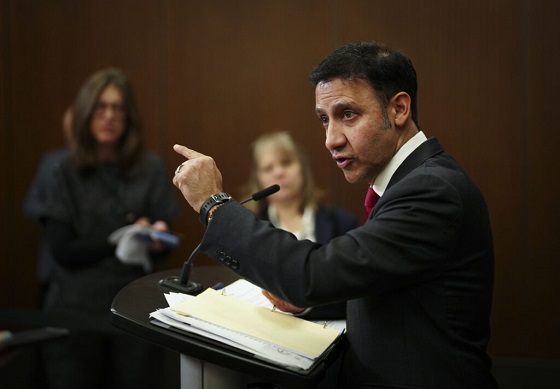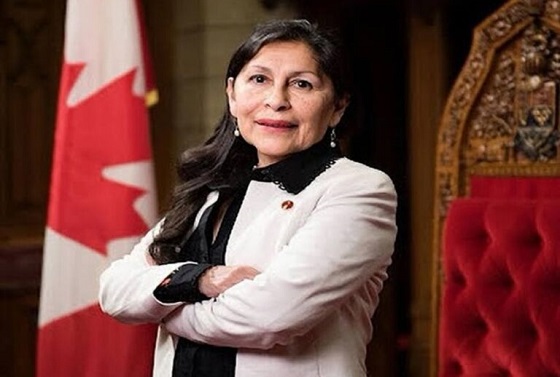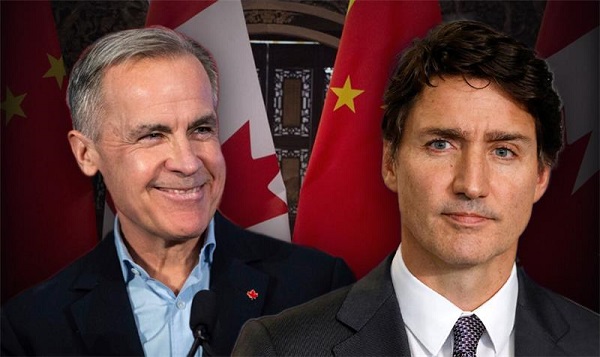National
Online Harms Act threatens free expression in Canada

News release from the Justice Centre for Constitutional Freedoms
This repudiates centuries of legal tradition that rightly reserved punishment for what a person had done, not for what a person might do. Under this new provision, a complainant can assert to a provincial court that they “fear” that someone will promote genocide, hate or antisemitism.
On February 26, Minister of Justice and Attorney General of Canada Arif Virani introduced Bill C-63, the Online Harms Act, in the House of Commons. The Online Harms Act is presented by the government as a means to promote the online safety of persons in Canada and reduce harmful content online. The Online Harms Act would impose severe penalties for online and offline hate speech, including life imprisonment, which is the most severe criminal punishment in Canada. This new legislation would establish a new Digital Safety Commission with power to enforce new regulations created by the federal cabinet. The Canadian Human Rights Commission would acquire new powers to prosecute and punish non-criminal hate speech.
Good intentions should be applauded
Although the Online Harms Act seriously threatens free expression in Canada, there are good intentions behind some of its provisions. It is a laudable goal to force online platforms to remove revenge porn and other non-consensual sharing of intimate images, content that bullies children, content that sexually victimizes children, content that encourages children to harm themselves, and content that incites violence, terrorism or hatred.
Unnecessary duplication of the Criminal Code
However, good intentions do not justify passing additional laws that duplicate what is already prohibited by Canada’s Criminal Code. Additional laws that duplicate existing laws are a poor substitute for good law enforcement.
Section 162.1(1) of Canada’s Criminal Code already prohibits online and offline publication of an intimate image without consent. Section 163 already prohibits publication of obscene materials and child pornography. Thus, it is already illegal to post online content that sexually victimizes a child or revictimizes a survivor.
Section 264(1) already prohibits criminal harassment. Section 319(1) already prohibits the public incitement of hatred towards a group that is identifiable by race, ethnicity, religion, sex, sexual orientation, gender identity, gender expression and other personal characteristics. Section 59(1) criminalizes sedition: advocating the use of force to achieve governmental change within Canada. Sections 83.21 and 83.22 criminalize instructing to carry out terrorist activity; any online content that incites terrorism is already illegal.
Further, Section 22 of Canada’s Criminal Code prohibits counselling, procuring, soliciting or inciting another person “to be a party to an offence.” Any person who counsels, procures, solicits or incites another person to be a party to an offence will be found guilty if the person receiving such counsel commits the offence in question. This applies to terrorism and other violent crimes, and even to minor criminal offenses like shoplifting. Further, section 464 of the Criminal Code criminalizes counselling another person to commit an offence even if that offence is not committed.
Those who support the Online Harms Act should explain why they believe that existing legislation is inadequate to address “harmful” online expression.
New government bodies to censor online speech
If passed into law, the Online Harms Act will create a new Digital Safety Commission to enforce compliance with new regulations created by the federal cabinet. This Digital Safety Commission will have the power to regulate nearly any person or entity operating as a “social media service” in Canada. Any person or social media service found to have permitted “harmful content” would face penalties. The severity of the penalties would be established by the federal cabinet. The creators and users of online content will self-censor to avoid the risk of running afoul of the new regulations and government-imposed censorship. The Online Harms Act provides that an Order of the Digital Safety Commission may be converted into an Order of the Federal Court and enforced like a Court Order. This could result in people operating social media services being fined and imprisoned for contempt of court if they refuse to censor Canadians’ speech.
Pre-emptive punishment for crimes not committed
The Online Harms Act, if passed into law, will add section 810.012 to the Criminal Code, which will permit pre-emptive violations of personal liberty when no crime has been committed. This repudiates centuries of legal tradition that rightly reserved punishment for what a person had done, not for what a person might do. Under this new provision, a complainant can assert to a provincial court that they “fear” that someone will promote genocide, hate or antisemitism. If the judge believes that there are “reasonable grounds” to justify the fear, the court can violate the liberty interests of the accused citizen by requiring her or him to do any or all of the following:
- wear an ankle bracelet (electronic monitoring device)
- obey a curfew and stay at home, as determined by the judge
- abstain from alcohol, drugs, or both
- provide bodily substances (e.g. blood, urine) to confirm abstinence from drugs or alcohol
- not communicate with certain designated persons
- not go to certain places, as determined by the judge
- surrender her or his legally owned and legally required firearms
In other words: a citizen who has not committed any crime can be subjected to one or more (or all) of the above conditions just because someone fears that that person might commit a speech crime in future. Further, if the person who has committed no crime fails to agree to these court-ordered violations of her or his personal liberty, she or he could be sentenced to up to two years in prison.
Our criminal justice system is not supposed to function this way. Violating the liberty of citizens through pre-emptive punishment, when no crime has been committed (and quite possibly when no crime will be committed), is a radical departure from centuries of common law tradition. The respect that our legal system has for individual rights and freedoms means that an accused person is presumed innocent until proven guilty by way of a fair trial, held before an independent and impartial court. We do not punish the innocent, nor do we restrict their liberty based on what they might do. The mere fear that harmful expression may occur is not a legitimate basis for court-ordered imprisonment or other conditions that violate personal liberty.
Life imprisonment for words spoken
For the existing Criminal Code offence of advocating for genocide, the Online Harms Act would raise the maximum penalty from five years in jail to life imprisonment. Free societies recognize the distinction between speech and actions. The Online Harms Act blurs that distinction.
Considering the inherent difficulty in determining whether a person has actually “advocated for genocide,” the punishment of a five-year prison term is already an adequate deterrent for words alone.
Federal cabinet can censor speech without input from Parliament
The Online Harms Act, if passed into law, would give new powers to the federal cabinet to pass regulations (which have the same force of law as legislation passed by Parliament) that place prohibitions or obligations on social media services. This includes passing regulations that impose fines or other consequences (e.g., the removal of a licence or the shutting down of a website) for non-compliance. New regulations can be created by the federal cabinet in its sole discretion, and do not need to be debated, voted on or approved by Parliament. Parliamentary proceedings are public. Any political party, or even one single MP, can raise public awareness about a Bill that she or he disagrees with, and can mobilize public opposition to that Bill. Not so with regulations, which are deliberated in secret by the federal cabinet, and that come into force without any public consultation or debate.
Apart from a federal election held once every four years, there is no meaningful way to hold cabinet to account for the draconian censorship of social media services by way of regulations and the harsh penalties that may be imposed for hosting “harmful content.” The federal cabinet can also decide what number of “users” the “social media service” needs to have in order to trigger federal regulation of content, or the federal cabinet can simply designate a social media service as regulated, regardless of the number of its users.
New censorship powers for Canadian Human Rights Commission
The Online Harms Act, if passed into law, will give the Canadian Human Rights Commission new powers to prosecute and punish offensive but non-criminal speech by Canadians if, in the subjective opinion of unelected and unaccountable bureaucrats, they deem someone’s statement to be “hateful.” The Online Harms Act will empower Canadians offended by non-criminal expression to file complaints against their fellow citizens.
Those who are prosecuted by the Human Rights Commission cannot defend themselves by establishing that their supposedly “hateful” statement is true, or that they had reasonable grounds for believing that their statement was true.
Those found guilty by the Canadian Human Rights Tribunal can be required to pay as much as $50,000 to the government, plus up to $20,000 to the person(s) designated as “victims” by the Canadian Human Rights Tribunal. These significant financial penalties will discourage or eliminate necessary discussion on controversial but important issues in our society.
Advocates for censorship often stress the fact that human rights prosecutions are not criminal. It is true that those found guilty of violating vague speech codes by the Canadian Human Rights Tribunal do not suffer the consequences of a criminal record. However, those who are prosecuted for expressing their beliefs face the difficult choice of having to spend tens of thousands of dollars on legal bills or having to issue an abject apology. Regardless of whether they choose to defend themselves against the complaint or not, they may still be ordered to pay up to $20,000 to the offended party or up to $50,000 to the government, or up to $70,000 to both.
Many Canadians will continue to exercise their Charter-protected freedom of expression, but many will self-censor to avoid the risk of being prosecuted by the Canadian Human Rights Commission.
Anonymous complaints: no right to face one’s accuser
The Online Harms Act, if passed into law, will allow complaints to be filed against Canadians in secret, such that the citizen who is prosecuted by the Canadian Human Rights Commission loses the ancient and well-founded right to face and question one’s accuser. This repudiates centuries of common law tradition requiring the legal process to be public and transparent.
The pretext for eliminating this necessary and long-standing legal protection is that some complainants might be subjected to “threats, intimidation or discrimination.” This ignores the fact that threats and intimidation are already Criminal Code offences, and any illegal discrimination can be addressed by way of a new and separate complaint. Those filing complaints about expression should be accountable for their decision to do so; this is an inherent and necessary component of both criminal and civil legal proceedings.
No need to establish that someone was harmed
If the Online Harms Act is passed into law, the Canadian Human Rights Commission will not even require a victim in order to prosecute a citizen for what she or he has said. For example, a man in Vancouver can file an anonymous complaint against a woman in Nova Scotia who made disparaging online remarks about a mosque in Toronto, regardless of whether that mosque’s members were harmed, or even offended, by the post. No actual victims are required for the Canadian Human Rights Commission to find guilt or to impose penalties. Nor does a victim need to prove that he or she suffered loss or damage; feeling offended by alleged “hate” is all that is needed to become eligible for financial compensation.
Conclusion
For reasons set out here above, the Online Harms Act will harm freedom of expression in Canada if it is passed into law. Many Canadians will self-censor to avoid being prosecuted by the Canadian Human Rights Commission. Canadians who do not self-censor, by practicing courage and by continuing to exercise their Charter-protected freedom of expression, will still see their online expression removed from the internet by the operators of social media websites and platforms. These operators will seek to avoid running afoul of Mr. Trudeau’s new regulations. Everyone will live in fear of the Digital Safety Commission.
The Justice Centre urges all Members of Parliament to vote against this legislation.
Banks
From Energy Superpower to Financial Blacklist: The Bill Designed to Kill Canada’s Fossil Fuel Sector

From Energy Now
By Tammy Nemeth and Ron Wallace
REALITY: Senator Galvez’s BILL S-238 would force every federally regulated bank, insurer, pension fund and Crown financial corporation to treat the financing of oil, gas, and coal as an unacceptable systemic risk and phase it out through “decommissioning.”
Prime Minister Mark Carney has spent the past weeks proclaiming that Canada will become an “energy superpower” not just in renewables but in responsible conventional energy as well. The newly created Major Projects Office has been proposed to fast-track billions in LNG terminals, transmission lines, carbon-capture hubs, critical-mineral mines, and perhaps oil export pipelines. A rumored federal–Alberta Memorandum of Understanding is said to be imminent from signature, possibly clearing the way for a new million-barrel-per-day oil pipeline from Alberta to British Columbia’s north coast. The message from Ottawa is clear: Canada is open for energy business. Yet quietly moving through the Senate is legislation that would deliver the exact opposite outcome.
Senator Rosa Galvez’s reintroduction of her Climate-Aligned Finance Act, now Bill S-238, following the death of its predecessor Bill S-243 on the order paper, is being touted by supporters not only as a vital tool for an “orderly transition” to a low-carbon Canadian economy but also to be “simply inevitable.” This Bill does not simply ask financial institutions to “consider” climate risk it proposes to re-write their core mandate so that alignment with the Paris Agreement’s 1.5 °C target overrides every other duty. In fact, it would force every federally regulated bank, insurer, pension fund and Crown financial corporation to treat the financing of oil, gas, and coal as an unacceptable systemic risk and phase it out through “decommissioning.” For certainty this means to:
“(i) incentivize decommissioning emissions-intensive activities, diversifying energy sources, financing zero-emissions energy and infrastructure and developing and adopting change and innovation,
(ii) escalate climate concerns regarding emissions-intensive activities of financially facilitated entities and exclude entities that are unable or unwilling to align with climate commitments, and
(iii) minimize actions that have a climate change impact that is negative.”
As discussed here in May, the reach of the Climate Aligned Finance Act is vast, targeting emissions-intensive sectors like oil and gas with a regulatory overreach that borders on the draconian. Institutions must shun financing and support of emissions-intensive activities, which are defined as related to fossil fuel activities, and chart a course toward a “fossil-free future.” This would effectively starve Canada’s energy sector of capital, insurance, and investment. Moreover, Directors and Officers are explicitly required to exercise their powers in a manner that keeps their institution “in alignment with climate commitments.” The Bill effectively subordinates traditional financial fiduciary responsibility to climate ideology.
While the new iteration removes the explicit capital-risk weights of the original Bill (1,250% on debt for new fossil fuel projects and 150% or more for existing ones) it replaces those conditions with directives for the Office of the Superintendent of Financial Institutions (OSFI) to issue guidelines that “account for exposures and contributions to climate-related risks.” This shift offers little real relief because mandated guidelines would still require “increased capital-risk weights for financing exposed to acute transition risks,” and the “non-perpetuation and elimination of dependence on emissions-intensive activities, including planning for a fossil-fuel-free future.”
These provisions would grant OSFI broad discretion but steer it inexorably toward punitive outcomes. As the Canadian Bankers’ Association and OSFI warned in their 2023 Senate testimony on the original Bill, such mechanisms would likely compel Canadian lenders to curtail or abandon oil and gas financing.
In plain language, Ottawa would be directing the entire financial system to stop lending to, insuring or investing in the very industries that are central to Canada’s economic future. In addition to providing tens of billions in royalties and taxes to governments each year, the oil and gas sector contributes about 3–3.5% of Canada’s GDP, generates over $160 billion in annual revenue and accounts for roughly 25% of Canada’s total exports.
The governance provisions proposed in Bill S-238 are beyond the pale. Board members with any past or present connection to the fossil fuel industry would have to declare it annually, detail any associations or lobbying involving “organizations not in alignment with climate commitments,” recuse themselves from every discussion or vote involving investments in oil, gas or coal, and make these declarations within a Climate Commitments Alignment Report. While oil and gas expertise is not banned outright, it is nonetheless ‘quarantined’ in ways that create a de facto purity test in the boardroom. At the same time, every board must appoint at least one member with “climate expertise”. Contrary to long-established principles for financial management, while seasoned energy experts would not be banned outright from such deliberations, they would effectively be sidelined on the very investment files where their expertise would be most valued.
The contradictions posed by Bill S-238 are simply breathtaking. The Major Projects Office is promising 68,000 jobs and CAD$116 billion in new investment, much of it tied to natural gas and oil-related infrastructure. These new pipeline and LNG export projects will require material private capital investments. Yet under Bill S-238 any bank that provides the capital needed for the projects would face escalating, punitive capital requirements along with public disclosure of its “contribution” to climate risks that are to be declared annually in a “Climate Commitments Alignment Report.” No MoU, Indigenous loan guarantee or federal permit can conjure financing out of thin air once Canada’s banks and insurers have effectively been legally compelled to exit the fossil fuel energy sector.
Current actions constitute a clear warning about the potential legal consequences of Bill S-238. Canada’s largest pension fund is currently being sued by four young Canadians who claim the Canada Pension Plan Investment Board (CPPIB) is failing to properly manage climate-related financial risk. Alleged are breaches of fiduciary duty through fossil fuel investments that are claimed to exacerbate climate risks and threaten ‘intergenerational equity’ with the demand that the CPP divest from fossil fuels entirely. The case, filed in Ontario Superior Court, demonstrates how financial institutions may be challenged in their traditional roles as stewards of balanced economic growth and instead used as agents for enforced decarbonization. In short, such legislation enables regulatory laws to re-direct, if not disable, capital investment in the Canadian non-renewable energy sector.
In May 2024, Mark Carney, then Chair of Brookfield Asset Management Inc. and head of Transition Investing, appeared at a Senate Committee hearing. He lauded the original Bill, calling key elements “achievable and actually essential” to champion “climate-related financial disclosures.” He noted that: “Finance cannot drive this transition on its own. Finance is an enabler, a catalyst that will speed what governments and companies initiate.” However, the new revised Bill S-238 goes far beyond disclosure. Like its previous iteration, it remains punitive, discriminatory and economically shortsighted, jeopardizing the very economic resilience that Carney has pledged to fortify. It is engineered debanking dressed up as prudential regulation.
This is at a time in which Richard Ciano described Canada as a land of “investment chaos”:
“While investment risk in the United States is often political, external, and transactional, the risk in Canada is systemic, legal, and structural. For long-term, capital-intensive projects, this deep, internal rot is fundamentally more toxic and unmanageable than the headline-driven volatility of a U.S. administration.
If the “rule of law” in Canada is meant to provide the certainty and predictability that capital demands, it is failing spectacularly. Investors seek clear title and dependable contracts. Canada is increasingly delivering the opposite. Investors don’t witness stability — they witness a fractured federation, a weaponized bureaucracy, and a legal system that injects profound uncertainty into the most basic elements of capitalism, like property rights.”
Bill S-238 is yet another example of how Canada is imposing unrealistic laws and regulations that contribute to investment uncertainty and that directly contradict policies proposed to accelerate projects in the national interest. While the Carney government trumpets Canada as a future energy superpower that produces and exports LNG, responsibly produced “decarbonized” oil and critical minerals, Bill S-238 would effectively limit, if not negate, the crucial financial backing and investments that would be required to accomplish this policy objective.
Rhetoric about nation-building projects is cheap. Access to capital is what turns promises into steel in the ground. This Bill would ensure that one hand of government will be quietly strangling what the other hand is proposing to do in the national interest.
Tammy Nemeth is a U.K.-based energy analyst. Ron Wallace is a Calgary-based energy analyst and former Member of the National Energy Board.
Crime
B.C.’s First Money-Laundering Sentence in a Decade Exposes Gaps in Global Hub for Chinese Drug Cash

Port Coquitlam Mayor Brad West met with Biden Secretary of State Antony Blinken in 2023, to discuss Canada’s enforcement gap on fentanyl money laundering.
Chinese underground-banking conviction is a baby step in a jurisdiction that some experts see as North America’s center of gravity for transnational crime.
In a milestone that is staggering for its rarity in a jurisdiction regarded as a global nexus of Chinese transnational money laundering that facilitates fentanyl trafficking for Mexican and Iranian gangs, British Columbia’s anti-gang unit has finally secured its first money laundering sentencing in a decade.
On Monday, a B.C. Supreme Court judge sentenced 37-year-old Richmond resident Alexandra Joie Chow to 18 months in jail for laundering the proceeds of crime, following a six-year investigation that targeted illegal Chinese underground casinos and unlicensed money transfer businesses in Metro Vancouver. The court also ordered the forfeiture of cash and bank drafts seized during the probe, the Combined Forces Special Enforcement Unit of B.C. (CFSEU) says.
Chow’s case marks the first time in roughly ten years that a money-laundering investigation in British Columbia has actually resulted in a sentencing — a remarkable data point in a province where hundreds of billions have washed through casinos, banks and real estate, according to The Bureau’s estimates, yet almost no one has been successfully prosecuted for the underlying financial crime.
While Chow’s case in itself is relatively small in dollar terms, it followed the catastrophic collapse of the RCMP’s E-Pirate probe into a Richmond underground bank called Silver International, which was alleged to have laundered over $1 billion through a network of Chinese Triad leaders known as “Sam Gor” or “The Company” — a scheme that moved drug cash collected in Chinese diasporas across North and Latin America, cycling the funds back to hundreds of accounts in China, in part through lending gang cash to Asian high-rollers who washed massive sums through B.C. government casinos.
The collapse of E-Pirate raised significant concerns in Washington around Canada’s capacity to prosecute fentanyl money laundering and trafficking. Vancouver-area Mayor Brad West has told The Bureau that the failure of Canadian authorities to secure convictions in that case was explicitly noted in 2023 by senior figures in the Biden administration, including Secretary of State Antony Blinken, in discussions about Canada’s role in North American drug trafficking.
Chow pleaded guilty in February 2025 to one count of laundering proceeds of crime after prosecutors alleged she was part of an underground loan-sharking and money-services scheme that operated in the Lower Mainland. Her plea came almost two years after B.C.’s Joint Illegal Gaming Investigation Team first announced charges.
The trail to that conviction began in August 2019, when B.C.’s Joint Illegal Gaming Investigation Team (JIGIT) quietly launched an investigation into the alleged loan-sharking and money-laundering activities of a man and a woman. Investigators believed the suspects were charging criminal interest rates and operating an unlicensed money services business.
Over the course of the probe, police say they developed evidence that the suspects allegedly laundered more than $828,000 in Canadian cash. On November 5, 2021, JIGIT executed a series of search warrants on properties in Richmond and Burnaby, as well as three vehicles associated to the investigation.
The searches resulted in the seizure of a number of items believed to be tied to money laundering and loan-sharking, including score sheets with client names and payment due dates, four cellular phones, two bank drafts totaling $50,000, and $10,680 in Canadian currency and three high-end vehicles.
Two years later, on November 1, 2023, the B.C. Prosecution Service approved four sets of charges against Chow: money laundering, possessing proceeds of crime, and entering into agreements to receive criminal-rate interest — classic loan-sharking. No other individuals were ultimately charged in the case.
As CFSEU-BC media officer Sgt. Sarbjit Sangha put it in the unit’s statement Monday, this is “the first time in a decade that a money laundering investigation in British Columbia has resulted in a sentencing,” and it “underscores the impact of collaborative investigative work” and JIGIT’s mandate to tackle illegal gaming tied to organized crime, loan-sharking and sophisticated bookmaking.
The scale of the enforcement gap this case exposes is critical to understanding current irritants between Washington and Ottawa, and the Trump administration’s leverage of tariffs on Canada. That campaign of economic pressure, some U.S. and Canadian officials have informed The Bureau, apparently extends from deep concerns in both the Biden and Trump administrations over Ottawa’s lack of meaningful action against massive money laundering through Canada’s financial system — including the TD Bank fentanyl money laundering case prosecuted in the Tri-State area, which exposed transactions similar to those revealed in the Chow investigation in Richmond.
The Cullen Commission into money laundering in B.C. found that by 2014, casinos in the province were accepting nearly $1.2 billion in cash transactions of $10,000 or more in a single year, many involving patrons who showed classic indicators of criminal cash — bricks of small bills delivered in bags by couriers closely watched by organized-crime investigators. JIGIT itself was created as part of the province’s response to that crisis. In a 2021 presentation to the Cullen Commission, then-Unit Commander Staff Sgt. Joel Hussey explained that JIGIT’s money-laundering and loan-sharking probes were focused on “top-tier” organized criminals exploiting casinos and banks, particularly at Richmond’s River Rock Casino Resort, Vancouver’s Parq Casino and Burnaby’s Grand Villa, where investigators saw the most entrenched high-roller criminal activity.
Yet the province’s record in actually getting such cases to the finish line has been abysmal. The most notorious example remains E-Pirate, the massive RCMP investigation that targeted Silver International, a Richmond underground bank alleged to be moving over $1 billion a year in drug and casino cash for Chinese and Mexican cartels and Middle Eastern networks. That case collapsed in 2018–2019 after federal prosecutors mistakenly exposed a confidential informant, leading to a stay of charges despite years of work and huge evidence seizures.
International bodies such as the Financial Action Task Force later used E-Pirate as a case study, describing a “professional” Richmond-hub laundering network that allegedly used B.C. casinos and real estate to clean and move drug proceeds on a global scale. Cullen’s final report, released in 2022, concluded that sophisticated money-laundering networks were moving “staggering amounts” of illicit funds through B.C., while law-enforcement and regulatory agencies failed to respond in a timely or coordinated way.
Whether Chow’s 18-month sentence becomes a template for future Vancouver Model prosecutions — or remains an isolated success in a province still struggling to hold money launderers to account — will be the next test for B.C.’s anti-gang and financial-crime enforcement regime.
Those questions are not just academic in Ottawa. As The Bureau has previously reported, senior officials in Washington — Democrats and Republicans alike — have for years warned that Canada’s failure to deliver sustained proceeds-of-crime prosecutions, and its lack of a RICO-style racketeering law, has turned the country into a structural weak point in North America’s fight against cartel-linked fentanyl networks.
As reported previously by The Bureau, in a high-level meeting in 2023, according to Vancouver-area Mayor Brad West, a longstanding critic of transnational drug networks in his province, Secretary of State Antony Blinken stressed that Washington believes Beijing is effectively weaponizing fentanyl against North Americans—and that Canada stands out as a worrisome weak link in the global supply chain.
West, reflecting on his encounter with Blinken, argued that only bold legislative change, coupled with a willingness to challenge entrenched legal barriers, can dispel the U.S. government’s unease over Canada’s approach. “Secretary Blinken specifically noted the lack of a RICO-style law in Canada,” West said. “He talked about how, in the United States, that law had been used to take down large portions of the mafia. Then he looked at us—one of America’s closest allies—and saw a very concerning weak link.”
According to West, Blinken pointed to China’s role in funneling precursor chemicals into fentanyl labs. He warned that China’s government, if inclined, could stem the flow but has little interest in doing so. “He was incredibly candid,” West recalled. “He confirmed the connection between the Chinese Communist Party, the triads, and the Mexican cartels, telling me these groups are working together—and it’s Canada where they’re finding a safe operating base.”
Blinken also conveyed to West that U.S. agencies had grown hesitant to share certain intelligence with their Canadian counterparts. “He told me that U.S. intelligence and law enforcement are withholding some evidence because they don’t believe we’ll act on it,” West explained. “They’ve lost confidence.”
West added that in ongoing communications, he had learned American officials are shocked that major figures in Asian organized crime “seem to have so much access to our political class. They’re basically saying, ‘What’s going on in Canada?’”
A major concern, according to West, is how known criminals manage to appear at political events or fundraisers with little oversight. “It’s not necessarily that politicians are complicit, but our political structures have weak guardrails,” West said. “The Americans see pictures of transnational criminals mingling at official gatherings and find it baffling.”
The Bureau is a reader-supported publication.
To receive new posts and support my work, consider becoming a free or paid subscriber.
-

 Great Reset1 day ago
Great Reset1 day agoRCMP veterans’ group promotes euthanasia presentation to members
-

 International1 day ago
International1 day agoBoris Johnson Urges Ukraine to Continue War
-

 International2 days ago
International2 days agoBeijing’s blueprint for breaking Canada-U.S. unity
-

 Business8 hours ago
Business8 hours agoFederal major projects list raises questions
-

 Daily Caller1 day ago
Daily Caller1 day agoEXCLUSIVE: Here’s An Inside Look At The UN’s Disastrous Climate Conference
-

 Health19 hours ago
Health19 hours agoOrgan donation industry’s redefinitions of death threaten living people
-

 MAiD1 day ago
MAiD1 day agoHealth Canada suggests MAiD expansion by pre-approving ‘advance requests’
-

 International1 day ago
International1 day agoTrump closes in on peace in Ukraine











